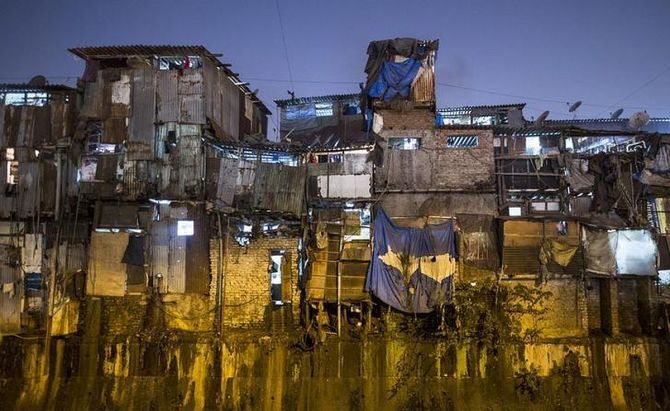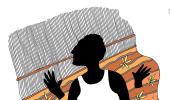Asia's largest urban slum, spread over 600 acres in the heart of India's financial capital, is home to an informal leather and pottery industry employing over 100,000.
Raghavendra Kamath reports.

Shankar Prajapati, a 57-year-old potter in Dharavi, has given up hope of getting a bigger house for his family. He lives cheek by jowl in a hutment measuring 200 square (sq.) feet (ft) in the nondescript shanty town.
“We have surrendered to our fate. We cannot wait forever for better accommodation.
"Perhaps we are not meant to dream big,” despairs Prajapati.
Raju Korde, president, Dharavi Redevelopment Committee, and a local resident, agrees with Prajapati.
“It has been 18 long years since the project was envisaged.
"At every election, promises are made. The people of Dharavi feel shortchanged,” he says.
Asia’s largest urban slum, spread over 600 acres in the heart of India’s financial capital, is home to an informal leather and pottery industry employing over 100,000.
Close to a million live in the area alone.
Originally conceived by the Vilasrao Deshmukh-led Congress government in 2004, the mega slum redevelopment project got stuck for nearly two decades for different reasons.
In November 2018, the then Devendra Fadnavis government approved a new model for the slum’s development.
Although Dubai-based Seclink Technologies Corporation turned out to be a successful bidder in January 2019 against Adani Group, the tender was not awarded, following a decision to include a railway land in the project.
Later, the project was caught in the cross hairs of power play between state and the Centre on the railway land handover.
Now the project has been given a new lease of life with the slum redevelopment authority (SRA) floating a request for proposal (RFP) for the project over the weekend.
The state has made many changes to make the project viable.
To begin with, the Dharavi redevelopment project is going to be bigger in size as its total area has been increased to 259 hectares, in line with the RFP issued by SRA. Earlier, it was 178 acres.
The project has a floor space index (FSI) of four for the redevelopment, along with several concessions in the form of premium paid by the developer, inspection charges, goods and services tax (GST), and so on.
The island city of Mumbai has an FSI of three for property projects.
With fungible FSI and transferable development rights (TDR), it can go up to five. For slum redevelopment projects, it can go up to eight, depending on the width of the road and the density of the slum.
FSI denotes the space allowed to be constructed on any given plot of land.
If a developer has 1,000 square (sq.) metres (m) of land, he can build up to a maximum of 5,000 sq. m in Mumbai.
The current plan for Dharavi also has some goodies attached to it.
The state urban development department will also give exemptions in certain provisions of development control regulations, and permission to invest/use TDR without indexation.
It will also propose an exemption to relax provisions of open leases in front of buildings, followed by relief in GST.
The Rail Land Development Authority and the Dharavi Redevelopment Project have signed an agreement to include a land parcel of 47.37 acres belonging to the former in the notified area.
It will help in the speedy development of the project, states the RFP document.
The SRA has issued an RFP for appointing a project management consultant to assist the selected bidder to obtain necessary approvals from relevant authorities, review plans and master plans prepared by a special purpose vehicle for the project.
Cost overrun
The cost estimated for the project has gone up 6.5x, from Rs 4,000 crore in 2004 to Rs 26,000 crore in 2019, when the Maha Vikas Aghadi government announced the project revival. Now, the cost is estimated to be Rs 28,000 crore.
Experts believe that costs had gone up by a minimum of 20 per cent in the past few years due to increase in raw material cost and labour.
Although input costs have stabilised, they are still higher than the previous year, observe developers.
Since the government is the biggest stakeholder, the administrative cost pertaining to approvals and licences may not have a big impact on the revised expenditure, says Prashant Thakur, senior director and head of research at Anarock Property Consultants.
“The key to success to one of the largest redevelopment projects in the world is to realign the development scope with a more sensitive rehabilitation programme that is flexible enough to incorporate an interdisciplinary approach that suits the local socioeconomic conditions,” says Thakur.
Higher values
“The policy environment is much better now and there is no ambiguity,” says Sanjay Dutt, managing director (MD) and chief executive officer (CEO) of Tata Realty and Infrastructure (TRIL), adding that valuations have also gone up manifold in the past two decades.
“If you recall, the Bandra Kurla Complex (BKC) was fetching Rs 10,000-11,000 per sq. ft for residential properties.
"Today, it commands Rs 65,000 per sq. ft for luxury properties.
"Costs have gone up and so has the valuation,” he adds.
Dharavi is just a 15-minute drive from the tony financial hub of BKC.
After redevelopment, Dharavi will be extended to BKC, clarifies Dutt.
Dutt says if the government provides a single-window clearance for approval, this can significantly improve valuations.
“There is enough private equity (PE) chasing good opportunities in Mumbai, enough developers to execute projects, and the government has come up with a rare opportunity to develop a large project,” he observes.
TRIL will study the project, says Dutt on being asked if the company would bid for it.
Niranjan Hiranandani, MD of Hiranandani Group, says with the railway land being made available for the project, it becomes more viable.
“Now you need not house too many people in transit as a large piece of land is added.
"You can straight away take the project forward,” says Hiranandani.
Amit Goenka, MD and CEO at Mumbai-based fund manager Nisus Finance, says while costs, including labour, input, and approvals, have gone up threefold, selling prices have gone up eightfold.
The project would be very profitable for developers, he surmises.
“Since it is close to BKC, there will be huge interest in the properties there,” says Goenka.
“I seriously don’t understand how costs have gone up from Rs 4,000 crore to Rs 30,000 crore.
"Construction cost at the very least could have gone up from Rs 2,000 to Rs 4,000 per sq. ft in 20 years.
"I don’t think a rise in raw material cost would affect much.
"When you run a 20-year project, you go through three to four commodity cycles. Costs will average out,” reasons a PE fund manager.











